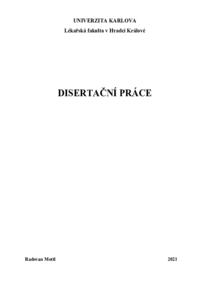Zlomeniny spodiny očnice
Orbital Floor Fractures
dizertační práce (OBHÁJENO)

Zobrazit/otevřít
Trvalý odkaz
http://hdl.handle.net/20.500.11956/152304Identifikátory
SIS: 147635
Kolekce
- Kvalifikační práce [1162]
Autor
Vedoucí práce
Oponent práce
Hauer, Lukáš
Pink, Richard
Fakulta / součást
Lékařská fakulta v Hradci Králové
Obor
Stomatologie
Katedra / ústav / klinika
Stomatologická klinika
Datum obhajoby
23. 9. 2021
Nakladatel
Univerzita Karlova, Lékařská fakulta v Hradci KrálovéJazyk
Čeština
Známka
Prospěl/a
Souhrn Autor sledoval závislost výskytu pooperačních komplikací (enoftalmus, diplopie a porucha inervace n. infraorbitalis) chirurgicky léčených zlomenin spodiny očnice na použitém implantačním materiálu, velikosti defektu a typu fraktury. Do studie bylo zahrnuto celkem 67 pacientů se zlomeninou spodiny očnice typu "pure" a "impure", kteří byli přijati na Stomatologickou kliniku FN HK, oddělení ústní, čelistní a obličejové chirurgie, v letech 2009 až 2020, byli indikováni k operačnímu výkonu a následně operováni. Jednalo se o 41 mužů a 26 žen. Ve studii byl použit implantační materiál poly-p-dioxanon ve formě PDS fólie tloušťky 0,5 mm (Ethicon, Johnson & Johnson, Deutschland), titanová síťka tloušťky 0,4 mm (Synthes GmbH, Oberdorf, Schweiz), materiál Medpor tloušťky 1,5 mm (Porex Surgical Products Group, Newnan, USA), individuálně zhotovený "Tomanův sloupek" a fyziologickým roztokem naplněný balónek Foleyova katétru. Výsledky práce ukazují, že při použití titanové síťky k rekonstrukci spodiny očnice došlo k vyššímu výskytu poruchy inervace n. infraorbitalis (p=0,0245) než při použití ostatních implantačních materiálů. Dále byl zaznamenán rozdíl ve výskytu enoftalmu 2 mm a více, závislém na relativní velikosti defektu spodiny očnice. Výskyt enoftalmu 2 mm a více byl statisticky významně častější u pacientů s...
Summary: Orbital floor fractures This work aimed to assess the impact of the implant material, the size of the defect, and the type of fracture on postoperative complications of surgically treated base orbit fractures. The monitored complications were enophthalmos, diplopia, innervation disorders of the infraorbital nerve. A total of 67 patients with "pure" and "impure" orbital fractures were enrolled in this study. The patients were examined, indicated for surgery, and operated at the Dentistry Clinic of the University Hospital in Hradec Kralove at the Department of Oral, Maxillofacial and Facial Surgery between 2009 and 2020. The group of patients included 41 men and 26 women. In the study, we compared several types of implant materials, i.e., 0.5 mm thick poly-p- dioxanone PDS foil (Ethicon, Johnson & Johnson, Germany), 0.4 mm thick titanium mesh (Synthes GmbH, Oberdorf, Switzerland), 1.5 mm thick Medpor (Porex Surgical Products Group, Newnan, USA), an individually made Toman column, and a Foley catheter balloon filled with saline. This study showed that the use of titanium mesh for the reconstruction of the orbit base led to a higher incidence of innervation disorders in the infraorbital nerve area (p=0.0245), compared to the use of other implant materials. Furthermore, a difference in the incidence of...
